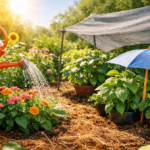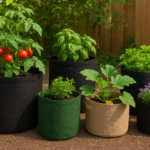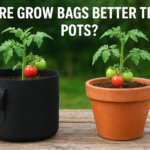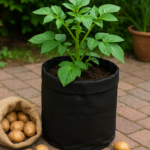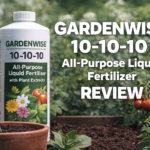The best liquid fertilizer for indoor plants, such as a 10-10-10 NPK ratio, is balanced. Opt for a formulation specific to houseplants for optimal growth.
Liquid fertilizers can dramatically enhance the growth and health of indoor plants. Liquid fertilizers are preferred for their ease of use and quick absorption, providing essential nutrients like nitrogen, phosphorus, and potassium directly to the roots of your plants.
A balanced liquid fertilizer tailored for indoor flora can promote lush foliage, robust growth, and vibrant blooms. Gardeners often use fertilizers with an equal ratio of the primary nutrients (N-P-K), which support the overall well-being of various houseplants.
What is fertilizer?
Fertilizer is a natural or synthetic substance added to soil or plants to enhance growth and productivity. It contains essential nutrients like nitrogen, phosphorus, potassium, and secondary and micronutrients. Fertilizers come in solid or liquid forms, and they are crucial in agriculture to replenish soil nutrients and boost crop yields. Careful use is necessary to prevent over-fertilization and potential harm to plants and the environment.
7 Best Liquid Fertilizers For Indoor Plants in 2024

Liquid fertilizers are a popular choice for indoor plants due to their ease of application and quick absorption by plants. Here are some types of best liquid fertilizers for indoor plants:
Miracle-Gro Water-Soluble All-Purpose Plant Food
key specs: 8 oz | Type: Liquid | Size: 15.75 x 10.75 x 4.75 inches | NPK: 24-8-16

Miracle-Gro Water Soluble All Purpose Plant Food provides essential nutrients for vegetables, trees, shrubs, and houseplants, promoting more extensive and beautiful growth. Miracle-Gro is water-soluble for various plants and features a 24-8-16 NPK ratio, providing essential nitrogen, phosphorus, and potassium.
The water-soluble form allows easy mixing and application via a garden feeder or watering can, ensuring instant plant nourishment and vibrant growth. Recommended for use every 1-2 weeks, the product is adaptable for outdoor and indoor plants, with specific guidelines for application. Miracle-Gro water-soluble plant food guarantees no plant burning when used as directed, making it a safe and available option in various sizes for different gardening needs.
Pros
- Enhanced Growth and Blooming
- Versatile Nutrient Boost
- Easy-to-Use Formula
- Balanced Nutrition for Healthy Plants
Cons
- Packaging Size
- Specific NPK Ratio
Espoma Organic Berry-Tone 4-3-4
key specs: Type: Granules | Size: 14.02 x 11.5 x 3.62 inches| NPK: 4-3-4

Berry-tone organic fertilizer is recommended for various berries such as blueberries, strawberries, raspberries, and blackberries. This fertilizer is a well-balanced blend of natural and organic ingredients, enriched with the exclusive Bio-tone formula, featuring a 4-3-4 fertilizer analysis with 5% sulfur. Notably, Berry-tone is environmentally safe and free from sludges or toxic components. It is best applied during planting or when feeding established plants, with a suggested schedule twice a year in early and late spring. Conveniently, Berry-tone is ready to use and requires no mixing. Importantly, it is approved for organic gardening and qualifies as a registered Organic Input Material, meeting all requirements for organic production.
Pros
- Organic Composition
- Balanced Nutrient Ratio
- Specifically Formulated for Berries
- Slow-Release Formula
Cons
- Application Frequency
FoxFarm FX14002 Big Bloom Liquid Concentrate
key specs: Type: Liquid | Size: 3.2 x 3.2 x 8.9 inches| NPK: 0 – .5 – .7

Fox Farm Big Bloom is a microbially active, water-soluble plant food designed to enhance blooming in flowering and fruiting plants. A formulation of .03-.1-.11 is 100% natural and organic, promoting large and multiple blooms while improving the flavor of fruits and vegetables. This instant plant food can be applied through various methods such as watering cans, foliar sprayers, drip irrigation, and hydroponic systems. It provides gentle nutrition without burning tender young plants. Big Bloom can be combined with Grow Big to customize the nutritional needs of all plants.
Pros
- Environmentally Friendly Formula
- Promotes Flowering
- Fruit Development
- Contains Beneficial Microbes
Cons
- Limited Macro Nutrients
Osmocote Smart-Release Plant Food
key specs: Type: Granules | Size: 4.25 x 7 x 13.5 inches | NPK: 14-14-14.

Osmocote Smart-Release Plant Food Flower & Vegetable is a slow-release fertilizer favoured for seasonal vegetables and perennials. It promotes strong roots as well as vigorous and bountiful above-ground growth. Specifically formulated for flavorful vegetables, colorful blooms, and perennials, this product provides up to 4 months of continuous feeding. Enjoy beautiful flowers and bountiful vegetables throughout the entire season. The product has a balanced NPK (Nitrogen, Phosphorus, Potassium) formula of 14-14-14.
Pros
- Smart-Release Technology
- Balanced NPK Ratio
- Reduced Risk of Over-Fertilization
- No Mixing Required
Cons
- May Not Be Suitable for All Plants
Schultz SPF70690 5# All Purpose Water Soluble
key specs: Type: Granules | Size: 9.5 x 4.75 x 4.75 inches| NPK: 20-20-20

Schultz SPF70690 5# All Purpose Water Soluble Plant Food 20-20-20 is a fast-acting, water-soluble fertilizer that is excellent for feeding all plants indoors and outdoors. It has a balanced NPK (Nitrogen, Phosphorus, Potassium) ratio of 20-20-20, making it suitable for many plants. The product is designed to “feed like nature” by dissolving nutrients and vital micronutrients evenly when it rains or is watered. This ensures that the nutrients are distributed evenly and are readily available for uptake by the plants. To use this product, you do not need to mix it with anything. Apply it directly to the soil around your plants. It is fast-acting, so you should see results quickly.
Pros
- Enhanced Plant Growth
- Versatile Application
- Quick Nutrient Absorption
- Long-lasting Results
Cons
- Risk of Over-Fertilization
MARPHYL Organic Liquid Fertilizer
key specs: Type: Liquid | Size: 3.11 x 3.11 x 9.25 inches | NPK: 2-0.1-3

MARPHYL Marine Phytoplankton is an ideal fertilizer for indoor and outdoor plants, serving as an excellent option for vegetables, houseplants, lawns, gardens, greenhouses, and hydroponics. Packed with nutrients, vitamins, and minerals, it goes beyond typical liquid plant fertilizers, promoting vibrant blooms and enhancing soil quality for trees, shrubs, vines, grass, flowers, and vegetables. This organic, all-purpose plant food is harvested naturally, vegan, non-toxic, non-GMO, and sustainably made. Safe for vegetable gardening, groundwater, and pets, it replenishes soil regularly to support continuous growth. The marine phytoplankton, rich in potassium, nitrogen, phosphorus, calcium, and magnesium, provides lush foliage and ensures the health and longevity of your lawn, garden, and indoor plants. Easy to use, mix with water in a 1:20 ratio and apply every two weeks for noticeable results after just one application.
Pros
- Organic and Natural
- All-Purpose Formula
- Rich in Micronutrients
- Soil Enhancement
Cons
- Limited NPK Information
Southern Ag Liquid Copper Fungicide
key specs: Type: Liquid | Size: 5.5 x 2 x 7 inches | NPK: 3-2-2

Southern Ag Liquid Copper Fungicide is a broad-spectrum fungicide designed to control diseases caused by bacteria and fungi on various plants, including fruits, vegetables, ornamentals, and turfgrass. The active ingredient is copper diammonia diacetate complex, equivalent to 8% metallic copper.
Pros
- Effective Fungicide
- Preventive and Curative
- Ideal for Organic Gardening
- Liquid Formulation
Cons
- Limited Efficacy on Some Diseases
Choosing the Right liquid fertilizer for indoor plants
Choosing the right fertilizer can be tricky, but with some knowledge, you can find the perfect one for your indoor plants. Liquid plant food for indoor plants is often preferred due to its ease of application and ability to control the nutrient supply. They are typically applied every 1 to 2 weeks, diluted in water.
Plant Type Specific Fertilizers
Other fertilizers are more appropriate for growing specific types of plants, like cacti or flowering plants. For instance, the Grow More Cactus Juice Cactus & Succulents Fertilizer is a superb choice for cacti. The JR Peters Jack’s Classic 10-30-20 Blossom is an excellent option for flowering plants due to its higher concentration of phosphorus.
Nutrient Requirements
Fertilizers are typically labeled with an N-P-K ratio, which stands for Nitrogen (N), Phosphorus (P), and Potassium (K). These are the three primary nutrients that plants need. A balanced fertilizer (e.g., 5-5-5 or 10-10-10) can be a good choice for general indoor plant care. However, depending on your plant’s specific needs, you might opt for a fertilizer with a different ratio.
Organic vs. Synthetic
Organic fertilizers are derived from natural sources like plants, animals, or minerals, while synthetic fertilizers are made from inorganic compounds. The use of organic fertilizers can be beneficial since they contain micronutrients and can improve soil quality over time. However, synthetic fertilizers are typically more concentrated and can provide nutrients more quickly.
How to apply liquid fertilizers to plants
Applying liquid fertilizers to plants involves several steps and considerations. Here’s a comprehensive guide:
- Read the Instructions: This is critical. Each fertilizer is different, and the manufacturer will provide the best instructions for that product. This includes how much fertilizer to use, how often, and any other safety precautions you should take.
- Dilute the Fertilizer: Liquid fertilizers often come in a concentrated form that needs to be diluted with water before application. The dilution ratio is usually specified on the product label. Following these instructions is essential to avoid over-fertilization, which can harm your plants.
- Application: Liquid fertilizers can be applied in two main ways: to the soil or directly on the leaves (foliar application). For soil application, you can use a watering can, bucket, or hose to deliver the diluted fertilizer to the base of the plant. This method ensures that the nutrients reach the root zone where the plant can absorb them. You can use a garden sprayer to spray the diluted fertilizer directly onto the leaves for foliar application. This method allows the plants to absorb nutrients quickly through their leaves, which can be beneficial if they need a quick nutrient boost.
- Timing: Liquid fertilizers are typically applied every 2-4 weeks, but the frequency can vary depending on the specific needs of your plants and the type of fertilizer you’re using. It’s best to apply liquid fertilizers in the early morning or late evening to avoid the hot sun, which can cause the fertilizer to evaporate before it’s absorbed.
- Pre-watering: Before applying the liquid fertilizer, it’s recommended to water the soil lightly. This ensures even wetting of the soil, which helps the liquid fertilizer reach the roots more effectively. It also helps prevent fertilizer burn if the product needs to be properly diluted.
Benefits of using liquid fertilizer for indoor plants
Liquid fertilizers offer several benefits for indoor plants, making them popular among enthusiasts. Here are some of the advantages:
- Easy Application: Liquid fertilizers are simple to apply; they do not need to work into the soil after application. They can be applied using garden sprayers, hose attachments, or watering cans, which makes the process straightforward.
- Immediate Absorption: Plants can immediately absorb liquid fertilizers, providing quick relief from nutrient deficiencies and boosting the growth of healthy plants. This is particularly beneficial for fast-growing plants that need frequent feeding.
- Uniform Nutrient Distribution: The nutrients in liquid fertilizers are distributed within the liquid, ensuring more uniform coverage and nutrient delivery to the plants.
- Versatility: Liquid fertilizers can be applied to the soil at the base of the plant or used as a foliar spray for even faster absorption. They can be diluted to suit the needs of delicate or light-feeding plants.
- Reduced Attraction of Pests: Unlike granular fertilizers, liquid fertilizers are less likely to attract digging pests that can disturb indoor plants.
- Fast-Acting: Liquid fertilizers act as there is no need for decomposition or breakdown, and they can be absorbed as the plant draws water.
- Control Over Application: With liquid fertilizers, gardeners have complete control over the application rate, which can help prevent overfertilization.
- No Risk of Freezing: Liquid fertilizers should not freeze; if they do, they may become unusable, so proper storage is essential.
- Immediate Delivery of Nutrients: Liquid fertilizers provide an immediate delivery of nutrients, which is especially useful if a plant shows signs of nutrient deficiency.
FAQs
What Is The Best Liquid Fertiliser For Indoor Plants?
The best liquid fertilizer for indoor plants is a balanced, water-soluble formula like a 20-20-20 blend, used at half-strength.
What Kind Of Fertilizer Is Best For Indoor Plants?
The best fertilizer for indoor plants is a balanced, water-soluble houseplant fertilizer with equal ratios of nitrogen, phosphorus, and potassium.
What Is The Best All-In-One Fertilizer For Indoor Plants?
The best all-in-one fertilizer for indoor plants is a balanced 20-20-20 liquid fertilizer, suitable for a wide range of houseplants.
Is Liquid Fertilizer Better For Indoor Plants?
Liquid fertilizer is not better for indoor plants; it depends on the plant’s needs and the caregiver’s preference. Granular options may also be effective. Choose a fertilizer based on your plant’s specific requirements.
Conclusion
when it comes to indoor plants, choosing the best liquid fertilizer is crucial for their health and growth. The number of options available can make it difficult to make the right decision. Considering factors such as nutrient composition, ease of application, and plant-specific needs, you can narrow down your options to find the ideal liquid fertilizer. Remember that the best liquid fertilizer for indoor plants will provide essential nutrients and promote healthy growth while being safe and easy to use. Conducting some research and reading product reviews can further assist you in making a well-informed decision. So, what is the best liquid fertilizer for indoor plants? It’s the one that suits the needs of your specific plants and provides them with the required nutrients, helping them thrive in their indoor environment. Happy planting!
You may also like: Best indoor plant potting soil for indoor plants


